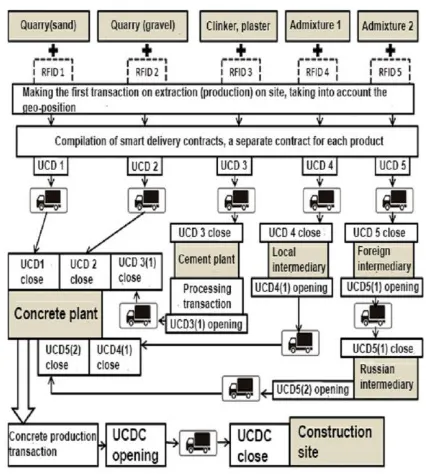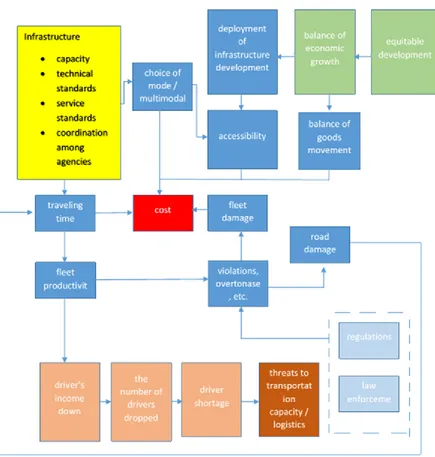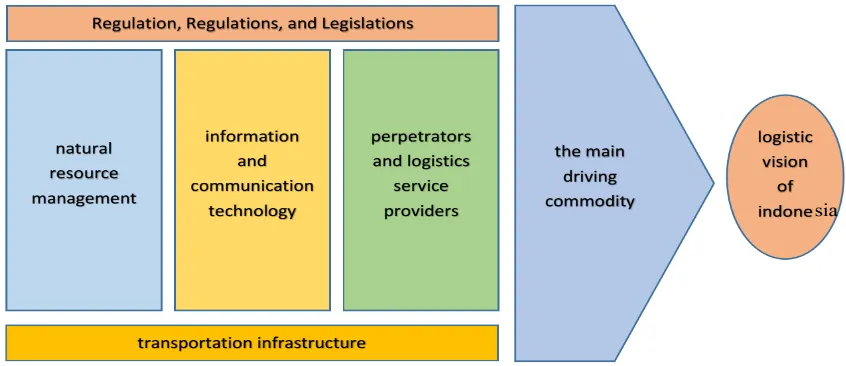A Preliminary Study of Supply Chain Management for Logistics
in Indonesia
Anita Ratnasari1, Wachyu Hari Haji2
Faculty of Computer Science, Universitas Mercu Buana, Jakarta Barat, Indonesia
ABSTRACT
Supply chain management is related to process of materials or supply management from basic raw of material supply to final deliverable product. Especially for agribusiness and agroindustry, supply chain management (SCM) deals with the management of commodity and product movements with varying time differences depending on geographic location. In Indonesia, there are many problems related to logistic which is impacted to logistic quality and price. The aim of this research is to collect data and identify factors that will support of SCM implementation. As the result, regulation and legislations is the factor that can support or inhibit supply chain management. The regulation and legislations of logistics supply chain management must be relevant with environmental regulation because logistics is related to natural resource management. To support data tracking and management, the logistics supply chain management can be supported by information and communication technology. The stakeholder can be tracked the logistics form perpetrators and logistics service providers and transportation used.
Keywords : Supply Chain Management, Logistics, Preliminary Study
I.
INTRODUCTIONThe definition of supply chain management is process of materials or supply management from basic raw of material supply to final deliverable product, including process recycling and re-use with proposed on how company used their suppliers' processes, technology and capability to get more competitive advantage [2].
The related works of supply chain have been done with different purposes. The research by Young and Peterson (2014) explored all of component of SCM itself, including physical, information, and financial flows. The component must be can operate functions of sourcing, making, delivering, returning and overarching planning overarching planning when responding to and recovering from emergency situations [3].
Research by Lynch (2018) explored the tools to support emergency SCM. Furthermore, they explained on how effective employment of hybrid airships responding to and recovering from emergency events in context of emergency SCM [4]. Lanko, Vatin, and Kaklauskas (2018) explored of implementation of Radio Frequency Identification (RFID) and block-chain technology to support creating a transparent system of interaction and transition between all participants in supply chain management [5].
Ama, Sediyono, and Setiawan (2014) discussed about the distribution of production in Minahasa, Indonesia. The research method used is research and development method. The design of the system is made by considering the aspects of functional and non-functional requirement [6].
chain management deals with the management of commodity and product movements with varying time differences depending on geographic location. Supply chain management can demonstrate the economic and conceptual relationships between producers, trade centres, and distribution chains among various parties with consumers [7].
In Indonesia, there are many problems related to logistic which is impacted to logistic quality and price. However, it can be tackled if logistic distribution is designed and handled with a good plan and management [8].
This research is part of research with titled Supply Chain Management System Model: A Case Study of Indonesia. In this time, we attempted to collect data and identify factors that will support of SCM
confirm the identified factors an collect data to model logistic supply chain management using UML [9].
II.
LITERATURE REVIEWThis section explored the fundamental of supply chain management and the related works.
A. Supply Chain Management
Supply chain management related to process of materials or supply management from basic raw of material supply to final deliverable product, including process recycling and re-use. The aim of supply chain management is how company used their suppliers' processes, technology and capability to get more competitive advantage [2].
B. Related Work
The related works of this research is derived based on the current development of supply chain management (SCM) and the condition of SCM in Indonesia.
The research by Young and Peterson (2014) explained SCM should integrate all of component of SCM itself, including physical, information, and financial flows. The component must be can operate functions of sourcing, making, delivering, returning and overarching planning overarching planning when responding to and recovering from emergency situations [3].
Study by Lynch (2018) explained the tools to support emergency SCM. Furthermore, they explained on how effective employment of hybrid airships responding to and recovering from emergency events in context of emergency SCM [4]. Lanko, Vatin, and Kaklauskas (2018) explained of implementation of Radio Frequency Identification (RFID) and block-chain technology to support creating a transparent system of interaction and transition between all participants in supply chain management [5].
Figure 2. Example of complete production and logistics chain in construction site [5].
Ama, Sediyono, and Setiawan (2014) discussed about the distribution of production in Minahasa, Indonesia. The research method used is research and research with titled Supply Chain Management System Model: A Case Study of Indonesia. In this research, we conducted five phases of research methodology, including literature study, data collection, data analysis, data presentation and conclusion, which is presented in Figure 2.
Figure 3. Research Methodology
In phase of literature study, we searched the relevant literature of supply chain management and found four literature, including Ama, Sediyono, and Setiawan (2014), Young and Peterson (2014), Lynch (2018), Lanko, Vatin, and Kaklauskas (2018). In second phase, we conducted data collection through Focus Group Discussion (FGD) [11] with member of Supply Chain Indonesia. Based on data from FGD, we conducted data analysis by using content analysis [12].
Literature Study
Data Collection
Data Analysis
Data Presentation
summarized in conclusion.
IV. RESULT
Transportation infrastructure became the main factor of supply chain management. The transportation is related to traveling time and cost that will be spent to
supporting factor of supply chain management also regulation and law to maintain and develop transportation infrastructure, and supply management. The factor is presented in Figure 2.
Figure 5. Main factor of supply chain management in Indonesia
Based on factors that are collected in Figure 4, we grouped the factors into main factors that is depicted in Figure 5. The main factor including regulation and legislations, natural resource management, information and communication technology, perpetrators and logistics service providers and transportation infrastructure.
V.
CONCLUSION AND FUTURE RESEARCH
Based on result of data analysis of data from Focus Group Discussion (FGD) with member of Supply Chain Indonesia, we conclude as follows:
1. The factor of transportation infrastructure became the main factor of supply chain management. The transportation is related to traveling time and cost that will be spent to delivered a raw or final product to costumer.
2. The regulation and legislations is the factor that can support or inhibit supply chain management [1]. The regulation and legislations of logistics supply chain management must be relevant with environmental regulation because logistics is related to natural resource management. To support data tracking and management can be supported by information and communication
technology [13]–[15], including for logistics supply chain management. The stakeholder can be tracked the logistics form perpetrators and logistics service providers and transportation used.
The future research of this research is confirmed factor with state-of-research and experts.
VI.
ACKNOWLEDGMENT
We completed our research by using research fund from Universitas Mercu Buana with scheme “Penelitian Internal” for 2017 - 2018.
VII.
REFERENCES
[1]. M. Porter and L. C. van Der, "Toward a new conception of the environment‐ competitiveness relationship," J. Econ. Perspect., vol. 9, no. 4, pp. 97–118, 1995.
[2]. K. C. Tan, V. R. Kannan, and R. B. Handfield, "Supply chain management: supplier performance and firm performance," Int. J. Purch. Mater. Manag., vol. 34, no. 3, pp. 2–9, 1998.
vol. 12, no. 2, pp. 171–87, 2014.
[4]. S. R. Lynch, "Consensus on the Effective Employment of Hybrid Airships in Future Disaster Logistics," 2018.
[5]. A. Lanko, N. Vatin, and A. Kaklauskas, "Application of RFID combined with blockchain technology in logistics of construction materials," in International Science Conference SPbWOSCE-2017 "Business Technologies for Sustainable Urban Development," 2018.
[6]. A. U. T. Ama, E. Sediyono, and A. Setiawan, "Perancangan Sistem Informasi Manajemen Rantai Pasok (Supply Chain Management) Untuk Distribusi Pangan Kabupaten Minahasa Tenggara.," in . Prosiding Seminar Ilmiah Nasional Komputer dan Sistem Intelijen (KOMMIT 2014), 2014.
[7]. E. G. Sa’id, "Manajemen Rantai Pasok Global dan Antisipasi Peningkatan Manajemen Rantai Pasok Pangan di Perusahaan Umum BULOG," J. Pangan, vol. 19, no. 1, 2010.
[8]. Republika, "Logistik Pangan Masih Jadi Kendala," Republika.co.id, 2016. Online]. Available:
http://www.republika.co.id/berita/koran/news- update/16/11/04/og46kg18-logistik-pangan-masih-jadi-kendala. Accessed: 26-Jan-2018]. [9]. M.-P. Huget, "An Application of Agent UML to
Supply Chain Management," in Proceedings of the Fourth International Bi-Conference Workshop on Agent-Oriented Information Systems, 2002.
[10]. S. Croom, P. Romano, and M. Giannakis, "Supply chain management: an analytical framework for critical literature review," Eur. J. Purch. Supply Manag. 6 67}83, vol. 6, pp. 67– 83, 2000.
[11]. A. Ramadhan, D. I. Sensuse, and A. M. Arymurthy, "A proposed methodology to develop an e-Government system based on Soft
Discussion (FGD)," in 2011 International Conference on Advanced Computer Science and Information Systems, 2011, pp. 147–152. [12]. M. Vaismoradi, H. Turunen, and T. Bondas,
"Content Analysis and Thematic Analysis: Implications for Conducting a Qualitative Descriptive Study," Nurs. Heal. Sci., vol. 15, no. 3, pp. 398–405, 2013.
[14]. A. Ratnasari, "Studi Pengaruh Penerapan e-Learning terhadap Keaktifan Mahasiswa dalam Kegiatan Belajar Mengajar Studi Kasus Universitas Mercu Buana Jakarta," in Seminar Nasional Aplikasi Teknologi Informasi (SNATI), 2012.
![Figure 1. Topic in supply chain management [10]](https://thumb-us.123doks.com/thumbv2/123dok_us/1040593.1129718/2.595.107.488.419.734/figure-topic-supply-chain-management.webp)


